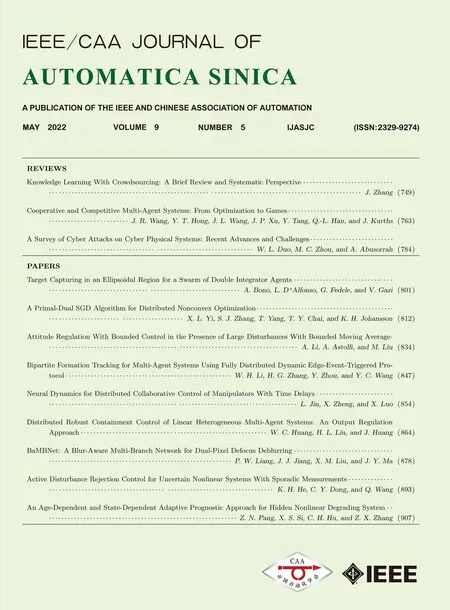Recursive Fault Estimation With Energy Harvesting Sensors and Uniform Quantization Effects
Yu-Ang Wang, Bo Shen,, and Lei Zou,
Dear Editor,
In this letter, the recursive fault estimation issue is considered for nonlinear time-varying systems subject to the effects induced by energy harvesting sensors and uniform quantization. Based on the energy harvesting mechanism and stochastic distribution of the absorbed energy, the real-time occurrence probability of missing measurements is calculated recursively. This research intends to develop a recursive estimator for the considered nonlinear timevarying system with energy harvesting sensors, such that, under uniform quantization effects, the state and fault can be jointly estimated. By adopting the induction approach, an upper bound is firstly calculated for the estimation error covariances (EECs) of the state and fault. Then, the value of the time-varying estimator parameter is computed through minimizing such calculated upper bound. In the end, an illustrative example is presented to verify the availability of the developed fault estimation method.
Fault estimation, which is a significant research issue in fault diagnosis field, has gained an ever-increasing research attention in recent decades. The main purpose of fault estimation is to estimate the “shape” and “size” for the underlying fault signal according to the available information (e.g., system model, received measurements,priori knowledge about the faults). So far, many interesting results concerning the fault estimation problems of different systems have been reported in the literature, see e.g., [1]–[3].
Quantization is considered to be an important source of the network systems performance. Such a research topic has attracted considerable research interest in recent years, see e.g., [4], [5]. To date, two kinds of quantization methods (i.e., the uniform-type quantization and the logarithmic-type quantization) have been adopted in the past literatures. In engineering practice, more and more energy harvesting sensors (EHS) are applied in practical systems for the aim of reducing the restriction of limited battery capacity on communication networks and providing permanent energy supply for remote devices. Under the effects of energy harvesting, a set of “rechargeable batteries” are adopted in sensors to store the energy absorbing from external environment (e.g., solar panels and wind mills) [6]. Nevertheless, the utilization of energy harvesting technique would give rise to certain distinguished phenomenon. More specifically, the measurement of sensor would be discarded if there is no energy stored in the sensor. The energy harvesting does result in measurement losses which, if not adequately tackled, would largely affect the filtering/control performance. So far, some preliminary results concerning the state estimation (or filtering) problem subject to EHS have been reported, see e.g., [6], [7].
Compared with the existing results on fault estimation problem, in this letter, we shall thoroughly consider the impacts induced by the energy harvesting mechanism, and discuss the estimation design and estimation performance analysis issues according to such impacts.Two major challenges in this letter are identified as follows: 1) How to develop a fault estimation scheme to handle nonlinearities and uniform quantization effects (UQE) under the EHS constraints? and 2) How to examine the transient behavior of the states and fault estimation error for the time-varying nature of the energy stored in the sensor? The main contributions of this work are highlighted as follows: 1) The fault estimation issue is, for the first time, studied for time-varying system (TVS) with EHS and UQE; 2) An upper bound(UB) of the estimation error covariance (EEC) is calculated recursively based on two coupled Riccati-like difference equations;and 3) The estimator gain matrix is calculated through minimizing the trace of the resultant EEC.
Problem formulation:System model and communication network:






Fig. 1. The energy harvested and energy consumption.

Fig. 2. The state xs and its estimate x?s.

Fig. 3. The additive fault fs and its estimate f?s.
Conclusions: In this research, the problem of recursive fault estimation has been studied for nonlinear TVSs subject to EHS and signal UQE. According to the probability distribution of the energy harvest process, the probability of missing measurement has been calculated recursively. The fault signal under consideration has been modeled by a time-varying function whose second order difference is assumed to be zero. A recursive fault estimator has been developed to generate the state estimates and fault estimate at each time instant.Then, the UB of the resultant EEC has been derived in terms of two coupled differences equations. The required time-varying estimator gain has been computed recursively by minimizing the UB of the EEC. A numerical example has been addressed to examine the availability of the developed fault estimation method. Future research directions include the fault estimator design issue over sensor networks with EHS [12]–[15].
Acknowledgments: This work was supported in part by the National Natural Science Foundation of China (61873059,61922024) and the Program of Shanghai Academic/Technology Research Leader (20XD1420100).
 IEEE/CAA Journal of Automatica Sinica2022年5期
IEEE/CAA Journal of Automatica Sinica2022年5期
- IEEE/CAA Journal of Automatica Sinica的其它文章
- Attitude Regulation With Bounded Control in the Presence of Large Disturbances With Bounded Moving Average
- A Primal-Dual SGD Algorithm for Distributed Nonconvex Optimization
- Knowledge Learning With Crowdsourcing:A Brief Review and Systematic Perspective
- Target Capturing in an Ellipsoidal Region for a Swarm of Double Integrator Agents
- A Survey of Cyber Attacks on Cyber Physical Systems: Recent Advances and Challenges
- Consensus Control for Multiple Euler-Lagrange Systems Based on High-Order Disturbance Observer:An Event-Triggered Approach
